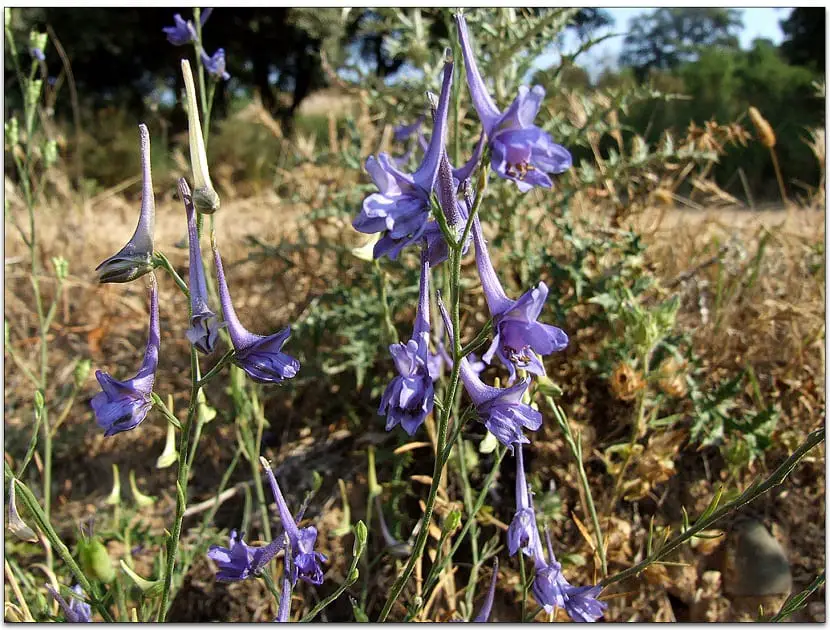
The slender dolphin It is a herbaceous plant of the genus Delphinium popularly known as guinea pig, espuelilla or delphinium. It tends to be confused with the plant of the same genus called halteringbecause they both grow in the same place. It is found in the wild, dispersed in regions of the Iberian Peninsula and also in North Africa. This species is characterized by having a very thin stem with practically no leaves, hence the name gracile, which means thin.
Delphinium gracile characteristics

The stem of this species can exceed 60 cm in height and, as its name suggests, they are quite thin and are branched, dry and glabrous. Palm-compound lower leaves, divided into lobes linear oblong y absent during the flowering season, while those that arise directly from the stem are intensely divided pinnatifid.
Its upper leaves are few, long and scattered. With a lax inflorescence, its flowers are purple in color, with long pedicels and spurs. Its fruit is dry, in number of 3 and inside they contain many black seeds.
Cultivation and care
The slender dolphin it is not an easy plant to grow. It requires a normal soil and an acid PH, which is well fertilized, it can be prepared by adding a mature mixture and fertilizer. The soil must be well drainedso that a possible stagnation of water does not occur.
This species prefers sunny locations on soils rich in organic substances. In relation to temperature, grows best in temperate and cold regions that have good humidity. However, it is a herbaceous plant that tolerates the heat and the rigors of winter well.
For its cultivation, sow the adult plants in the spring period, while the cuttings are better than the plants during the fall. Herbs that are properly adapted and developed need fertilizers to be applied to the baseusing organic products. In consideration of its height and slender stems, it is important that you secure the plant with a stake to prevent the wind from blowing it down.
Regarding irrigation and after its cultivation it is important that you apply abundant irrigation and then continue with this but at regular intervals, particularly in the summer time. You must sow it during the month of February On the surface of a small glass container (compote), you cover it with polyethylene mulch at a temperature of approximately 16º C. Once germination has occurred, you proceed to remove the mantle and then cover the seeds with vermiculite.
When you notice that the seedlings are already large enough to be handled, you place them in larger jars, approximately 9 liters. You put them outside during the winter and then sowing them in June. There are those who begin the entire procedure in June and end it in September.
Regarding pruning, this can be done in mid-March as follows; take the youngest, strongest and healthiest shoots between 7 and 10 centimeters, closest to the head. Then you clean the soil with a brush and water and remove the basal leaves and keep only one. Dampen the cuttings in a suitable fungicide.
In greenhouses you must plant them in half-filled jars and place it on a tray with enough water, making sure that it moistens the base of the plant. The jars should be stored at a temperature of 14 ° C in a place with good lighting, but avoiding direct sunlight.
The rooting of the cuttings will take place after 30 days, but you must make sure that everything is fine and try to eliminate all the material that is deteriorated. Once occurred in rooting, they are transferred to 9 liter jarscomposed of cuttings and 10% perlite, you secure them to the ground in a dry place. When they have stabilized sufficiently, you place the cuttings outdoors so that they settle well and plant them in the month of May.
Diseases and parasites

This species is prone to attack by diseases and parasites, particularly powdery mildew that attacks the flowers of the plant. These plants are not recommended to be too close togethersince a good air circulation must be guaranteed. To avoid potential fungal outbreaks, it is important to apply fungicide before new sprouts open.

